| C H A P T E R 1 |
|
Introduction to the Clustered Database Platform 280/3 |
The Clustered Platform 280/3 with Oracle9i and Sun Cluster High Availability software provides the infrastructure for implementing a highly available Oracle9i database using Sun Cluster HA Oracle agents with VERITAS Volume Manager or Solstice DiskSuite.
This document is intended for system administrators who are familiar with the Solaris Operating Environment and with the following software: Solstice DiskSuite, Sun
Operating Environment and with the following software: Solstice DiskSuite, Sun Management Center (Sun MC), Sun Enterprise Explorer, Sun StorEdge
Management Center (Sun MC), Sun Enterprise Explorer, Sun StorEdge Component Manager, VERITAS Volume Manager (VxVM), and Sun Cluster software.
Component Manager, VERITAS Volume Manager (VxVM), and Sun Cluster software.
This chapter contains the following topics:
For specific information about configuring disk sets, disk volumes, file systems, and data services, refer to the Sun Cluster 3.0 documentation.
The Clustered Platform 280/3 system is a self-sustained platform, integrated through the Sun Cluster technology, with shared, mirrored Fibre Channel-Arbitrated Loop (FC-AL) storage to support highly available applications. You can use this two-node cluster system to implement a highly available file server, web server, mail server, or an Oracle database server. Sun Cluster 3.0 provides global file systems, global devices, and scalable services. These features allow independent cluster nodes, running independent Solaris Operating Environment (Solaris OE) instances, to run distributed applications while providing client access through a single IP address.
database server. Sun Cluster 3.0 provides global file systems, global devices, and scalable services. These features allow independent cluster nodes, running independent Solaris Operating Environment (Solaris OE) instances, to run distributed applications while providing client access through a single IP address.
FIGURE 1-1 is a basic block diagram of the system, which includes a two-node cluster with shared, mirrored storage, a terminal concentrator, and a management server. An Ethernet hub provides connection between the cluster nodes, management server, and Sun StorEdge T3 arrays. The interfaces on both nodes are cabled to provide multiple cluster interconnects between nodes.
The management server is the repository for the operating environment, software, and patches. The management server provides access to the cluster console and functions as a JumpStart Flash server (installation server) for the cluster nodes. For advanced system monitoring, the management server includes Sun Management Center (Sun MC) software to monitor the cluster nodes.
Flash server (installation server) for the cluster nodes. For advanced system monitoring, the management server includes Sun Management Center (Sun MC) software to monitor the cluster nodes.
|
Note - This clustered platform only provides a basic clustered environment. You must install and configure your data services after you have customized and configured the system. |
The Clustered Database Platform 280/3 system does not have a monitor. You access the platform using a system on the network that you provide (shown as your local system in FIGURE 1-1). The local system is used as a remote display to the management server. You do not need to dedicate any particular machine as the local system.

Your factory-integrated Clustered Platform 280/3 system includes the following hardware components:
 expansion cabinet which includes two power sequencers, one front door option, one rear door, and one fan assembly
expansion cabinet which includes two power sequencers, one front door option, one rear door, and one fan assembly
 T1 AC200 server configured with one 500 MHz UltraSPARC
T1 AC200 server configured with one 500 MHz UltraSPARC IIe CPU, 1-Gbyte of memory, two internal mirrored 18-Gbyte boot disks, and a DVD-ROM drive
IIe CPU, 1-Gbyte of memory, two internal mirrored 18-Gbyte boot disks, and a DVD-ROM drive
 280R servers, with two 900-MHz UltraSPARC III CPUs, 2-Gbytes of memory, two mirrored 36-Gbyte boot disks, and a DVD-ROM drive
280R servers, with two 900-MHz UltraSPARC III CPUs, 2-Gbytes of memory, two mirrored 36-Gbyte boot disks, and a DVD-ROM drive
 T3 arrays, each with 1-Gbyte controller board cache and nine 36-Gbyte or 72.4-Gbyte disk drives.
T3 arrays, each with 1-Gbyte controller board cache and nine 36-Gbyte or 72.4-Gbyte disk drives.
 PCI cards per node installed in PCI1 and PCI2 slots; two FC-AL PCI host adapter cards per node installed in PCI3 and PCI4 slots
PCI cards per node installed in PCI1 and PCI2 slots; two FC-AL PCI host adapter cards per node installed in PCI3 and PCI4 slots
The Clustered Database Platform 280/3 system includes the following major software components on the management server:
The following major software components are installed on the clustered nodes:
 Management Center 3.0 Update 2 agent software
Management Center 3.0 Update 2 agent software
 Server Enterprise Edition, 32-bit, release 1, patch set 2
Server Enterprise Edition, 32-bit, release 1, patch set 2
The Clustered Database Platform 280/3 system is shipped with two volume management products. You choose, during the initial configuration, whether to use VERITAS Volume Manager 3.1.1 or Solstice DiskSuite 4.2.1 to mirror the data on the clustered nodes. Solstice DiskSuite software is used to mirror the boot disk on the management server.
Copyright © 2002, Sun Microsystems, Inc. All rights reserved.